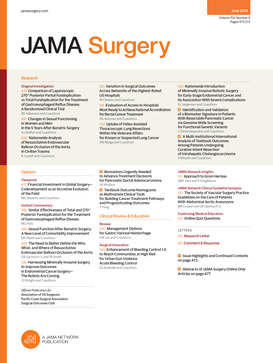Food Insecurity in US Surgical Patients
IF 15.7
1区 医学
Q1 SURGERY
引用次数: 0
Abstract
ImportanceFood insecurity, defined as uncertain access to enough food for a healthy life, is a growing issue in the US. While its link to chronic conditions is well documented, little is known regarding its impact on surgical patients.ObjectiveTo assess food insecurity, identify associated characteristics, and measure the rate of Supplemental Nutrition Assistance Program (SNAP) enrollment among surgical patients using a nationally representative sample.Design, Setting, and ParticipantsThis was a cross-sectional study using National Health Interview Survey (NHIS) data from 2011 through 2018. These data were analyzed from February 2024 through April 2025. Multivariable logistic regression models were used to analyze the association between surgery, food insecurity, and enrollment in SNAP. Data for this study came from the NHIS, a nationally representative survey used for health information, health access, and health behaviors of the civilian, noninstitutionalized US population, enabling broad applicability to surgical patients. The study included 254 283 individuals with data on surgery within the past year and 30-day food insecurity. Surgical and nonsurgical cohorts were created based on answers to, “During the past 12 months, have you had surgery or other surgical procedures as an inpatient or outpatient?”ExposuresThe main exposure included undergoing surgery in the past year. Other exposures were age, race, sex, employment status, household income, marital status, number of family members in the household, geographic region, health status, and insurance status.Main Outcomes and MeasuresThe proportion of food insecurity among the surgical cohort was the main outcome. Secondary outcomes included factors linked to food insecurity and SNAP enrollment, especially for those with incomes below 200% of the federal poverty level.ResultsSurgical patients (13 180 male [40.2%] and 19 643 female [59.8%]) reported higher food insecurity prevalence (11.6%) than nonsurgical patients (100 924 male [45.6%] and 120 536 female [54.4%]) (10.5%). Adjusted analyses indicated significantly higher odds of food insecurity among surgical patients (odds ratio, 1.12; 95% CI, 1.07-1.18;美国外科病人的食物不安全
在美国,食品不安全是一个日益严重的问题,食品不安全的定义是无法获得足够的食物来维持健康的生活。虽然它与慢性疾病的联系是有据可查的,但它对外科病人的影响却鲜为人知。目的评估食品不安全状况,确定相关特征,并测量外科手术患者中补充营养援助计划(SNAP)的入学率。设计、环境和参与者这是一项使用2011年至2018年全国健康访谈调查(NHIS)数据的横断面研究。这些数据是从2024年2月到2025年4月进行分析的。采用多变量logistic回归模型分析手术、食品不安全和SNAP入组之间的关系。本研究的数据来自NHIS,这是一项具有全国代表性的调查,用于调查美国平民、非机构人口的健康信息、健康获取和健康行为,因此可以广泛适用于手术患者。这项研究包括254283人,他们在过去一年中接受了手术,并在30天内没有食物保障。手术组和非手术组是根据以下问题的答案创建的:“在过去的12个月里,你作为住院病人或门诊病人接受过手术或其他手术吗?”暴露主要暴露包括在过去一年中接受过手术。其他暴露因素包括年龄、种族、性别、就业状况、家庭收入、婚姻状况、家庭成员人数、地理区域、健康状况和保险状况。主要结局和措施手术队列中食物不安全的比例是主要结局。次要结果包括与粮食不安全和SNAP入学有关的因素,尤其是那些收入低于联邦贫困水平200%的人。结果手术患者(男性13 180人[40.2%],女性19 643人[59.8%])的食物不安全发生率(11.6%)高于非手术患者(男性100 924人[45.6%],女性120 536人[54.4%])(10.5%)。调整后的分析显示,手术患者发生食物不安全的几率明显更高(优势比,1.12;95% ci, 1.07-1.18;P, amp;肝移植;措施)。粮食不安全与收入较低和健康状况不佳密切相关。SNAP的入学率为16%,其中40%的手术患者收入低于联邦贫困线的200%,与年轻,低收入,失业,受教育程度较低或公共保险患者相关。结论与相关性食品不安全是外科手术患者的一个重要负担。包括粮食不安全筛查在内的干预措施可能会改善该队列的粮食获取和健康结果。
本文章由计算机程序翻译,如有差异,请以英文原文为准。
求助全文
约1分钟内获得全文
求助全文
来源期刊

JAMA surgery
SURGERY-
CiteScore
20.80
自引率
3.60%
发文量
400
期刊介绍:
JAMA Surgery, an international peer-reviewed journal established in 1920, is the official publication of the Association of VA Surgeons, the Pacific Coast Surgical Association, and the Surgical Outcomes Club.It is a proud member of the JAMA Network, a consortium of peer-reviewed general medical and specialty publications.
 求助内容:
求助内容: 应助结果提醒方式:
应助结果提醒方式:


